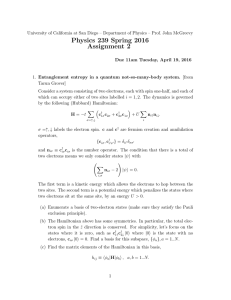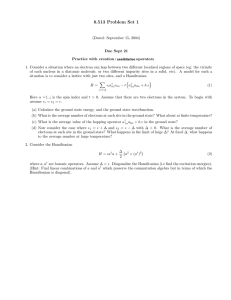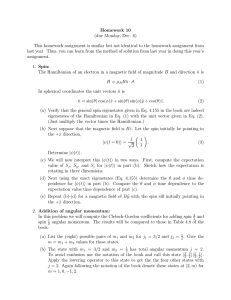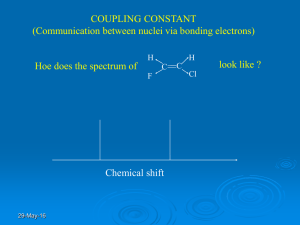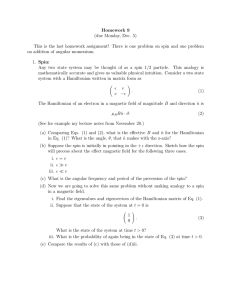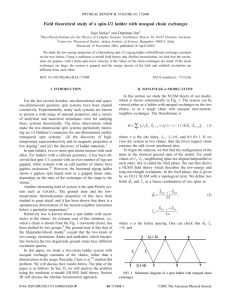8.513 Problem Set 6
advertisement
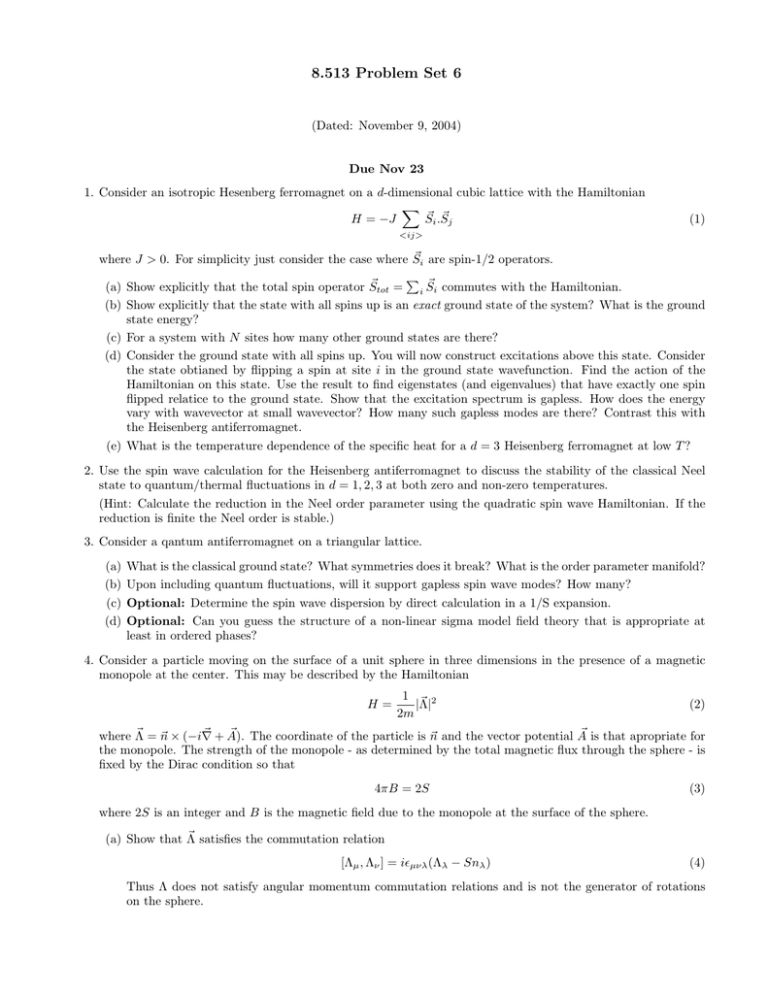
8.513 Problem Set 6 (Dated: November 9, 2004) Due Nov 23 1. Consider an isotropic Hesenberg ferromagnet on a d­dimensional cubic lattice with the Hamiltonian � �i .S �j H = −J S (1) <ij> �i are spin­1/2 operators. where J > 0. For simplicity just consider the case where S �tot = � S � (a) Show explicitly that the total spin operator S i i commutes with the Hamiltonian. (b) Show explicitly that the state with all spins up is an exact ground state of the system? What is the ground state energy? (c) For a system with N sites how many other ground states are there? (d) Consider the ground state with all spins up. You will now construct excitations above this state. Consider the state obtianed by flipping a spin at site i in the ground state wavefunction. Find the action of the Hamiltonian on this state. Use the result to find eigenstates (and eigenvalues) that have exactly one spin flipped relatice to the ground state. Show that the excitation spectrum is gapless. How does the energy vary with wavevector at small wavevector? How many such gapless modes are there? Contrast this with the Heisenberg antiferromagnet. (e) What is the temperature dependence of the specific heat for a d = 3 Heisenberg ferromagnet at low T ? 2. Use the spin wave calculation for the Heisenberg antiferromagnet to discuss the stability of the classical Neel state to quantum/thermal fluctuations in d = 1, 2, 3 at both zero and non­zero temperatures. (Hint: Calculate the reduction in the Neel order parameter using the quadratic spin wave Hamiltonian. If the reduction is finite the Neel order is stable.) 3. Consider a qantum antiferromagnet on a triangular lattice. (a) (b) (c) (d) What is the classical ground state? What symmetries does it break? What is the order parameter manifold? Upon including quantum fluctuations, will it support gapless spin wave modes? How many? Optional: Determine the spin wave dispersion by direct calculation in a 1/S expansion. Optional: Can you guess the structure of a non­linear sigma model field theory that is appropriate at least in ordered phases? 4. Consider a particle moving on the surface of a unit sphere in three dimensions in the presence of a magnetic monopole at the center. This may be described by the Hamiltonian H= 1 � 2 |Λ| 2m (2) � = �n × (−i� � + A). � The coordinate of the particle is �n and the vector potential A � is that apropriate for where Λ the monopole. The strength of the monopole ­ as determined by the total magnetic flux through the sphere ­ is fixed by the Dirac condition so that 4πB = 2S (3) where 2S is an integer and B is the magnetic field due to the monopole at the surface of the sphere. � satisfies the commutation relation (a) Show that Λ [Λµ , Λν ] = i�µνλ (Λλ − Snλ ) (4) Thus Λ does not satisfy angular momentum commutation relations and is not the generator of rotations on the sphere. 2 (b) Show that the correct angular momentum operators are instead � =Λ � + S�n L (5) � satisfy the expected commutation with �n and Λ. � Show explicitly that the L � requires that L2 has eigenvalues l(l + 1) with 2l (c) The commutation algebra of the different components of L an integer. In addition Lz may be diagonalized simultaneously with L2 and (for any fixed l) has eigenvalues m in the range −l, −l + 1, ....., +l. Show that � 2 + S2 L2 = Λ (6) This implies the inequality l(l + 1) ≥ S 2 so that the minimum possible value of l is S. (d) Armed with these results consider the spectrum of the Hamiltonian in Eqn. 2. What is the ground state energy? What is the angular momentum and degeneracy of the ground state? What is the angular momentum of the first excited state? What is the energy gap from the ground state? (e) Derive a path­integral that describes the motion of this particle (for instance the imaginary time path integral for the partition function). (Hint: First construct the path integral assuming a general spherically symmetric potential in three di­ mensions, and at the end of the calculation specify that this potential constrains the motion to be on the surface of a unit sphere). (f) Show that the m → 0 limit reduces to the spin path integral derived in class. Consider this limit in the Hamiltonian framework. Show that both the ground state energy and the energy gap go to infinity in this limit. The divergence of the ground state energy has no physical consequence as we may redefine the zero of energy by adding a constant term to the Hamiltonian. The divergence of the energy gap means that the only states that survive in this limit are those in the ground state. This explains why the path integral reduces to the one for spin in the m → 0 limit.
